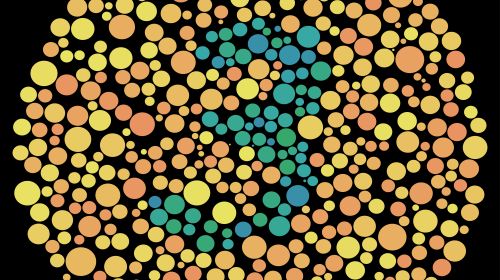Red-green weakness is often confused with being color-blind. Only the colors red and green are more difficult to distinguish from one another. What the causes are, how those affected see the world and why more men than women have color vision problems.
- With a red-green weakness it is difficult to distinguish certain colors.
- © iStock.com/MediaProduction
At a glance:
Red-green weakness: what is it?
Red-green weakness is a so-called color impairment, in which red and green can be seen and differentiated more difficult. This color ametropia is usually congenital. Men are more often affected than women.
The red-green weakness is the most common color disorder. The term colloquially summarizes two visual impairments:
Green weakness (deuteranomaly): Most common form of color ametropia. The color green is seen more weakly and can hardly be distinguished from red. 4.63 percent of men and 0.36 percent of women are affected.
Red weakness (protanomaly): The color red is more difficult to recognize and can hardly be distinguished from green. 1.08 percent of men and 0.03 percent of women live with this color weakness.
Blue vision can also be disturbed. In the case of blue weakness (tritanomaly), blue and purple tones are perceived weakly and yellow is only poorly recognized. This is why it is also known as blue-yellow disorder. However, this form occurs much less frequently than red-green weakness and is often triggered by a disease of the retina or the optic nerve.
A congenital color disorder does not affect vision. Affected people perceive the world of colors differently than people with normal eyesight. They usually get along well with it.
Recognize and see colors
On the retina are receptors that are responsible for color vision, so-called cones. The cones contain photo pigments that are differently sensitive to different wave ranges of light. They are divided into:
- B or blue cones respond to short-wave light
- G or green cones respond to medium wave light
- R or red cones respond to long-wave light
If the photo pigments work according to their sensitivity, the entire spectrum of our color world is mixed from the three colors red, green and blue. However, if the sensitivity of a cone type shifts to a different wave range, the color perception changes.
Difference between color and color blindness
The terms red-green weakness, red-green blindness or color blind are often used synonymously. However, these are different color impairments. In the case of color vision problems such as red-green weakness, certain colors can no longer be recognized or differentiated well. The eyesight for this is still available. Someone who is color blind, on the other hand, can no longer see a certain color. The cones for the respective color are missing in this case. The wrong color and the associated color gradations are then displayed in shades of gray. Incidentally, green blindness is the most common color blindness. This also affects men more often than women.
With color blindness, one, two or all three cones can fail. If all three cone types are missing, only black, white and gray tones can be perceived. Then one speaks of total color blindness. However, this visual disturbance is very rare.
Causes of a red-green weakness
People with red-green weakness usually have this from the beginning of their life, because it is inherited. The genes for the color-specific pigments red and green are located on an X chromosome. That is also the reason why more men than women have a red-green weakness. Men only have one X chromosome, while women have two. If the color gene on one of the genome carriers is damaged, women can compensate for this error with the healthy chromosome. In this case, the woman is only the carrier of the genetic defect, but can pass it on to her children.
But diseases of the retina or the optic nerve can also impair color vision and lead to red-green or blue-yellow disorders. Either one eye or both are affected. Possible causes are:
How do people with red-green weakness see?
People with an innate red-green weakness grow up with a different world of colors. Those affected do not notice this color error at first. If the family does not know about the genetic defect, the disorder is often only discovered during school days or during a color sense test, which is required for certain professions, such as pilots.
Depending on how strongly the sensitivity of the red or green photo pigment is disturbed, this also affects color vision. Some see red and green only with minor deviations. Then green, for example, is just a little more dull. Others cannot distinguish the two colors at all. For example, you will then see all red tones green.
The red-green weakness is equally pronounced in both eyes and does not change in the course of life. This does not affect or worsen eyesight.
Diagnosis: picture tests for red-green weakness
The main aim of the examination is to clarify whether the color blindness has been present for life or only recently. Because in the second case an eye disease could be the cause. Therefore, during the anamnesis, the doctor asks, for example, whether:
Is there a known hereditary red-green weakness in the family?
Both eyes are affected or only one eye?
Are there signs such as flashes of light, flickering or color shifts?
There are numerous tests to check color vision, for example with color charts. There are many small colored circles on these that show numbers or lines. Only normal sighted people can distinguish the figures and numbers from the background and interpret them correctly.
Ishihara tablets: Is the best known test with color charts and is used to diagnose red-green weakness. The tables contain mostly numbers, with the color impaired see different numbers than normal sighted. How many boards are recognized incorrectly or not at all shows how strong the red-green disorder is. A blue-yellow disorder cannot be determined with this test.
Stilling tablets: Works on the same principle as the Ishihara tablets. But they also contain color charts to diagnose a blue-yellow disorder.
CVTME test: Stands for "Color Vision Testing Made Easy" and is a color test for children aged three and over. The test panels contain easy-to-recognize symbols such as circles, stars, dogs or boats.
Other color tests are the Farmsworth test or the PV-16 test, in which colored chips or papers must be placed in the order of their correct color gradation.
The anomaloscope is also one of the diagnostic instruments. The color mixing device is similar to a microscope and is mainly used to test aptitude for certain professions for which the ability to distinguish colors is particularly important. This test is necessary, among other things, for people who want to work for the police, the military, as a pilot, truck driver or ship captain.
Course and treatment
No therapy is possible in the case of congenital red-green weakness, it cannot be cured. It can only be determined how severe the disorder is. In principle, however, it does not deteriorate either. Those affected usually get along well with it in their lives.
There are now glasses or contact lenses that are colored and can compensate for a color weakness to a certain extent.
Restrictions for everyday life and work?
A red-green weakness only slightly restricts everyday life. Because those affected learn to cope well with it. You help yourself with tricks by doing
- Writing on colored everyday objects such as pens,
- Sort clothes by color,
- or remember the order of traffic light signals or the like.
However, there is a greater impediment to choosing a career. Those affected cannot carry out certain jobs because the recognition of colors, color signals or color coding is relevant. These include professions such as policeman, pilot, electrician, photographer, painter, graphic artist or train driver.
Red-weak people also have more problems in road traffic because they see red darker and therefore see brake lights more poorly.


